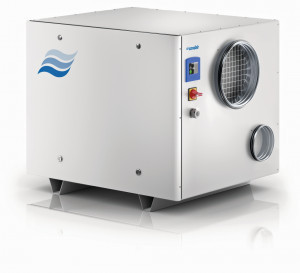Maintaining the value of historic vehicles and classic cars requires controlled humidity in the storage area. Whether VW Beetle or BMW Series 02, Tin Lizzie or Pontiac Firebird - classic cars are an impressive testimony to the historical development of mobility. Correct storage of the classic car plays a decisive role here, as corrosion is one of the greatest risks to value retention.
Condensation forms a breeding ground for rust
Here's a little theory: when warmer and humid room air meets a cooler surface, condensation forms. Due to the rapid cooling of the air in the immediate vicinity of the surface, it very quickly reaches its dew point, i.e. the state in which the air is already 100 percent saturated with water vapor and therefore cannot absorb any more water molecules. As a result, the excess water vapor condenses into fine water droplets, which are then visibly deposited on the cooler surface.
If warmer and humid indoor air meets a cooler surface, condensation forms
The relative humidity describes how saturated the air is and how close it is to the saturation line. At different temperatures, the air can absorb different amounts of moisture. In principle, the higher the temperature, the more water can be absorbed. In addition, at every temperature there is a certain point at which the air is unable to absorb more moisture. This point is known as the saturation or dew point. From here, condensation begins to form.
The ambient air is subject to fluctuations over the course of the day, especially in spring and fall - it is relatively mild during the day and drops sharply at night. There is a temperature difference between the air and the metal of the vehicle. The dew point is reached and condensate is deposited on the components.
Atmospheric corrosion
The water vapor condensing out of the air on the components leads to a chemical reaction known as atmospheric corrosion - rust forms. Oxygen meets iron and takes two electrons from it. A thin layer of iron II oxide is formed. This process is not yet harmful; on the contrary, the iron oxide layer protects the iron from further destruction. However, when the moisture from the condensate comes into play, the oxygen does not combine with the iron, but reacts with the water molecules. The iron compensates for the loss of electrons in the water by releasing atoms. The iron slowly dissolves and the component is destroyed in the long term.
Classic cars are particularly sensitive
Old vehicles are often much more sensitive to corrosion than cars from modern production due to the materials and mechanisms used. They often have cracks in the paintwork or exposed metal on the chassis, making them susceptible to moisture. Corrosion inside the engine is particularly dangerous because it is not immediately recognizable. Here, the parts are not protected by paint or a special surface coating. Moisture penetrates the inside of the engine through open valves and condensation can form on the cylinders and surfaces. But leather, fuel and oils are also damaged if it gets too damp. Upholstery and textile materials can quickly become moldy if the air is very humid.
However, an absolutely dry parking space with minimal humidity is also not the right solution to preserve the value of the classic car, because if the ambient air is too dry, moisture is drawn out of veneered dashboards, vinyl components such as convertible roofs or interior trim and soft plastic. The material becomes brittle and porous and cracks appear.
Control and actively regulate the indoor climate
 Adsorption dryers hold the water vapor contained in the air on hygroscopic surfaces - and absorb itToavoid these risks, active control of the air humidity is required. Experts from Hagerty, an insurance company specializing in classic cars, recommend a relative humidity of around 55%. This value can be maintained at a constant level using dehumidifiers. Their electronic control ensures that the desired humidity is always maintained. A basic distinction can be made between two operating principles: Condensing dehumidifiers and adsorption dryers.
Adsorption dryers hold the water vapor contained in the air on hygroscopic surfaces - and absorb itToavoid these risks, active control of the air humidity is required. Experts from Hagerty, an insurance company specializing in classic cars, recommend a relative humidity of around 55%. This value can be maintained at a constant level using dehumidifiers. Their electronic control ensures that the desired humidity is always maintained. A basic distinction can be made between two operating principles: Condensing dehumidifiers and adsorption dryers.
Active humidity control is required to avoid risks
Condensing dehumidifiers are based on a refrigeration process; they contain a refrigeration machine with compressor, evaporator and condenser. This is used to cool down a surface in the device, on which the water vapor from the air condenses and the air is thus dehumidified. Such devices are used when the relative humidity should be between 40 and 60 % (at a room temperature of around +5 to +35 °C).
However, if the room temperature is rather low - such as in an unheated hall in winter - the use of adsorption dryers is recommended. Such devices hold the water vapor contained in the air on hygroscopic surfaces - they absorb it. The main adsorbent used is silica gel, which is regenerated in a drying drum. To maximize energy efficiency, the adsorption dryers should be equipped with highly efficient fan drives - EC motors (brushless DC motors) save up to 50 % energy compared to conventional AC motors.
In order to maintain the value of a classic car for a long time, it is not just a matter of thinking about screws, spare parts, oils and maintenance. It is also about heating, ventilation and choosing a suitable solution for controlled humidity. Then nothing stands in the way of enjoying your own piece of automotive history for many years to come.
Photos: Condair



